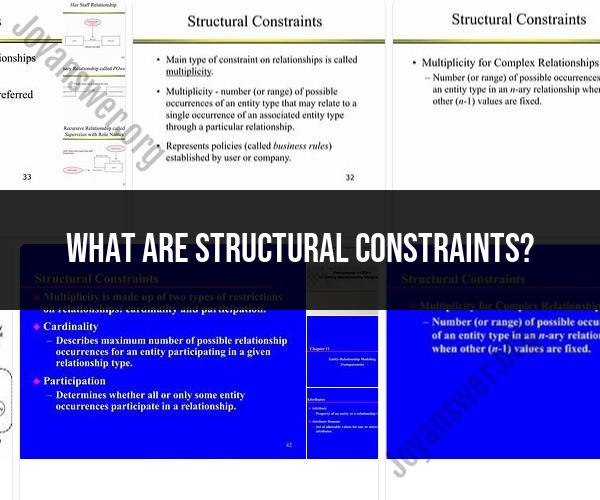What are structural constraints?
Structural constraints refer to the limitations or boundaries imposed by the physical, social, cultural, or organizational aspects of a system. These constraints can significantly influence the range of possibilities and actions within that system. Navigating structural constraints involves understanding how these limitations impact decision-making, problem-solving, and creative thinking. Here are some key points to consider:
1. Types of Structural Constraints:
- Physical Constraints: These include limitations imposed by the physical environment, such as geography, resources, and infrastructure.
- Social and Cultural Constraints: Societal norms, values, and cultural practices can shape behaviors and limit certain actions.
- Organizational Constraints: Within institutions and organizations, structures like hierarchies, policies, and procedures can impact decision-making and operations.
- Economic Constraints: Financial limitations can impact available resources and options.
- Regulatory and Legal Constraints: Laws and regulations can define what is permissible and what is not within a given context.
2. Impact on Possibilities:
- Structural constraints define the scope of what can be achieved or attempted. They set the boundaries for creativity and innovation.
- They can encourage resourcefulness and adaptation as individuals and organizations seek to work within limitations.
- Constraints can promote efficiency by narrowing down options and focusing efforts on viable solutions.
3. Creative Problem-Solving:
- Navigating constraints often requires thinking creatively to find innovative solutions that work within the limitations.
- Constraints can inspire out-of-the-box thinking and unconventional approaches.
4. Balancing Constraints and Possibilities:
- Identifying opportunities within constraints is essential for maximizing possibilities while acknowledging limitations.
- It's important to weigh the potential benefits of taking risks against the potential negative consequences of challenging certain constraints.
5. Cultural Sensitivity:
- In diverse contexts, cultural constraints must be acknowledged and respected. Cultural competence is crucial for effective navigation.
6. Collaborative Approaches:
- Collaborative efforts can help identify and address structural constraints collectively, leveraging the strengths of multiple perspectives.
7. Innovation and Adaptation:
- Navigating constraints often drives innovation and adaptation. Examples include finding sustainable solutions in resource-scarce environments.
8. Strategic Decision-Making:
- Decision-makers must consider structural constraints when formulating strategies and plans.
- Balancing short-term objectives with long-term impacts is essential.
9. Identifying Opportunities:
- Constraints can also reveal unmet needs and untapped opportunities for development and improvement.
In summary, navigating structural constraints involves understanding the boundaries and limitations that exist within a given system and using creative problem-solving and strategic thinking to work within those limitations. By acknowledging these constraints and finding innovative ways to address them, individuals and organizations can discover new possibilities and avenues for growth.


